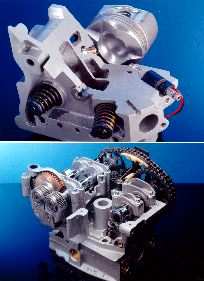
|
|
MERCEDES-BENZ ENGINE TECHNOLOGY AT FRANKFURT 1999 |
|
|
At the Frankfurt Motor Show (IAA), the Stuttgart-based marque is giving the public an insight into it's current state of engine development. The most important aim of the engine designers is to achieve even further reductions in the exhaust emissions of car engines, in order to meet the strict limits of EU exhaust directives and future US pollutant limits. Mercedes-Benz reckon that one highly promising process for the spark ignition engine of the future is variable valve timing. 'Variable' here means that the valves are not opened and closed by the conventional continuous control principle of the camshaft but that their opening times are adapted to the particular driving situation. This method avoids the otherwise common throttling of the engine, which detracts from efficiency in the partial load range and is therefore responsible for the higher fuel consumption in urban and short-haul traffic. With an eye to the future, engineers are therefore speaking of 'throttle-free load control'. Other manufacturers have already launched such systems, but none yet are infinitely variable. This is Mercedes' aim. In the advanced engine development division at Mercedes-Benz, two variable valve timing methods are being put through their paces on test rigs and in practical road tests: one system is mechanical and uses two camshafts, whilst the other is electromagnetic, with actuators on each valve. The decision on whether to implement these technologies in full-scale production will depend on the final outcome of these tests. |
|

|
Variable valve timing by mechanical system: two camshafts
For drivers, the tangible effects of this throttle-free engine control system are more agile engine response at low and medium revs and an increase of about 10% in torque in the engine speed range up to 3000rpm. Both of these features provide good foundations for improved elasticity and for even greater driving pleasure. |
|
The advantages of this mechanically variable valve timing system in terms of fuel consumption are just as impressive: with the 3.2-litre V6 engine, Mercedes engineers have recorded a fuel saving of about 8% in the New European Driving Cycle (NEDC), equivalent to about 0.9 litres per 100 kilometres in the Mercedes-Benz S320.
Variable valve timing by electromagnets: free valve play
The system consists of one actuator per valve, so that the cylinder head of a modern 4-cylinder engine will have a total of 16 of these powerful actuators. Microcomputers on each cylinder bank control the actuators by regulating the power supply to the electromagnets. These microcomputers also control the ignition and fuel injection functions. The almost unlimited variability of valve timing provided by electromagnetic actuators, and the resulting ability to dispense with a throttle valve for load control, leads to a substantial reduction in the fuel losses normally incurred in the charge exchange process, so that the NEDC fuel consumption of a Mercedes-Benz E-Class saloon is reduced by about 10%. This fuel saving effect is even more marked in combination with the automatic cylinder cut-out system that Mercedes-Benz has developed for the V8 engine of the S500: in this combination, the 8-cylinder engine uses about 15% less fuel - a saving of just under two litres per 100 kilometres.
Direct petrol injection: many questions still unanswered
On the basis of the modern 4-cylinder engine of the A-class, Mercedes engineers have already tested a large number of DI engines on test benches and in test vehicles. This major investment is necessary, because a whole range of basic questions still need to be solved for this injection and combustion system. These questions include emission control, because conventional three-way catalytic converters are not suitable for DI petrol engines: the chemical conversion process of conventional converters only works optimally with a fuel-air mix ratio of 1:14.6 (lambda 1/stoichiometric), whereas DI petrol engines benefit from mainly running on lean-burn mixtures, which may permit considerable fuel savings but are incompatible with the principle of the regulated three-way catalytic converter. |
|
|
Emission control by accumulator-catalyst: sulphur-free fuel required
|

|
|
Use of the accumulator-converter and compliance with the strict emission control regulations of the EU-4 Directive would therefore only be possible if the oil industry were to supply petrol with a sulphur content of less than 10 ppm (parts per million), i.e. a 'sulphur-free' fuel according to the technical definition. Unfortunately, the currently permissible sulphur content and the EU levels planned for the years 2000/2005 are much too high and are incompatible with future emission control technologies such as the accumulator-converter. In the view of Mercedes-Benz, one solution would be to grant tax concessions for sulphur-free fuel - a measure which has already proved highly successful in the introduction of unleaded fuel.
Fuel economy with the DI principle: between eight and fifteen percent
However, the considerable fuel savings achieved for the diesel engine by direct injection cannot be attained on the same scale with petrol engines. Although this system, in combination with lean-burn operation, theoretically offers a high potential for fuel savings in the SI engine, in practice, and taking into account the strict EU-4 emission standards, the results are less impressive than those obtainable with the CDI engine. In addition, in the particularly high-economy operating mode in the partial load range, the DI petrol engine can only develop up to about a fifth of its maximum power. Consequently, with a slightly more sporty driving style, there are no measurable fuel savings. In the NEDC driving cycle, Mercedes experts in Stuttgart estimate an overall fuel saving of eight to fifteen percent. |
|
Main news page
| [Contents] [Home] [News] [Features] [Car of the Week] [Motorsport] [A-Z] |